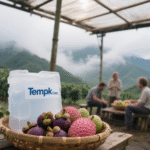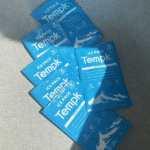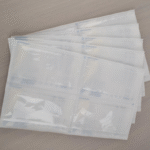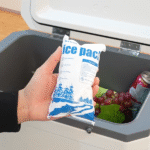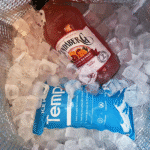Are Dry Ice Packs Food-Safe for Shipping Perishables?
Dry ice packs are a widely used solution in the food industry for shipping perishable items. Their ability to maintain ultra-low temperatures makes them ideal for keeping food frozen during transit. Aber are dry ice packs food-safe? This article answers that question by exploring dry ice’s properties, its use in food preservation, Sicherheitsprotokolle, and best practices for handling.
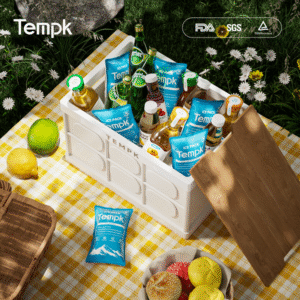
Was sind Trockeneisbeutel?, and Why Are They Important for Food Safety?
Trockeneis, eine feste Form von Kohlendioxid (Co₂), sublimates directly into gas at -78.5°C (-109.3° F), bypassing the liquid phase of normal ice. This unique property allows dry ice to maintain low temperatures for extended periods, making it an essential tool for preserving frozen food during shipping. Jedoch, proper handling is necessary to ensure safety.
How Does Dry Ice Work to Preserve Food?
Dry ice is extremely effective in preventing food spoilage during transportation by maintaining frozen states, especially for sensitive products like ice cream, Fleisch, und Meeresfrüchte. It does this by keeping the temperature consistently below freezing, which prevents thawing and bacterial growth.
Are Dry Ice Packs Safe for Food?
Dry ice itself is ungiftig, but it poses risks due to its extreme cold. Direct contact with dry ice can cause frostbite or cold burns on food, leading to undesirable texture changes, Gefrierbrand, or even food damage. The key safety principle when using dry ice is to prevent direct food contact.
Best Practices for Using Dry Ice in Food Shipping
Here are some crucial guidelines for ensuring the safe use of dry ice for food applications:
-
Verpackung & Separation
Use insulated containers that prevent direct contact between dry ice and food. Ensure proper separation using Schaumkühler, Luftpolsterfolie, oder cardboard layers. -
Belüftung ist der Schlüssel
Always use packaging that allows the sublimated CO₂ gas to escape. Vermeiden Sie luftdichte Behälter, as they can cause Druckaufbau, das könnte gefährlich sein. -
Handhabung und Lagerung
Immer tragen Kryogene Handschuhe Und safety goggles beim Umgang mit Trockeneis. Trockeneis in lagern well-ventilated spaces, away from heat or direct sunlight, to avoid dangerous buildup of CO₂ gas. -
Transportation and Compliance
Beim Versand, ensure vehicles are well-ventilated to prevent CO₂ accumulation. Always follow the regulatory guidelines for shipping hazardous materials and include “Contains Dry Ice” labeling as per regulations.
What Alternatives to Dry Ice Are Available for Safe Food Shipping?
While dry ice is effective for longer shipments, Gelpackungen Und Phasenveränderungsmaterial (PCMs) are becoming more popular for Kurzzeitlieferungen. These alternatives are safer and easier to handle as they don’t involve hazardous CO₂ gas.
| Kühlmittel | Trockeneisbeutel | Gelpackungen | PCMs |
|---|---|---|---|
| Temperaturregelung | Extrem kalt (-78.5°C) | Moderate cold (0° C bis -20 ° C.) | Customizable for specific ranges |
| Sicherheit | Erfordert eine besondere Handhabung; hazardous | Ungiftig, Essenssicher | Ungiftig, safe for direct contact |
| Dauer | Lang anhaltende (12-48 Std.) | Shorter duration | Longer than gel packs, but varies |
| Umweltauswirkungen | Co₂ -Emissionen | Biodegradable or recyclable | Biodegradable, umweltfreundlich |
Hybridlösungen: Combining Dry Ice and Gel Packs
For shipments that require both deep freezing Und Kühlung, combining dry ice with gel packs can create a stable temperature environment. This hybrid solution works especially well for longer transit times, ensuring that sensitive food products stay gefroren oder gekühlt without risk of rapid thawing.
Common Mistakes and How to Avoid Them
-
Lagern Sie niemals Trockeneis in luftdichten Behältern – CO₂ gas needs to escape to avoid dangerous pressure buildup.
-
Vermeiden Sie direkten Kontakt mit Lebensmitteln – Use insulation layers between the dry ice and food to prevent freezer burn.
-
Schutzausrüstung tragen – Never handle dry ice with bare hands. Verwenden Isolierte Handschuhe Und safety goggles.
How to Safely Ship Different Types of Food
Gefrorene Meeresfrüchte (24-36 Std.):
Combine Trockeneis mit Gelpackungen. Place seafood in an airtight plastic wrap, then surround it with gel packs and a layer of dry ice (durch Karton getrennt).
Mahlzeiten (24 Std.):
Verwenden Gelpackungen und an Isolierter Liner to maintain the appropriate refrigeration temperature. Place one gel pack above and one below the food for balanced temperature control.
Impfungen (48-72 Std.):
Use certified medical shipping containers with built-in ventilation, Kombinieren Trockeneis mit PCMs to maintain a steady temperature.
2025 Trends in Cold Chain and Dry Ice Usage
Der cold chain packaging market is projected to grow from USD 29.1 Milliarde In 2025 to USD 50.5 Milliarde von 2035. Key trends shaping the future of dry ice use in food shipping include:
-
Nachhaltige Materialien – Use of biologisch abbaubar Und recycelbar gel packs and insulation materials.
-
IoT & Echtzeitüberwachung – Integration of Sensoren Und RFID -Tags to monitor food temperature throughout the shipping process.
-
Smarter Packaging Solutions – Advancements in Phasenveränderungsmaterial for better temperature control.
Abschluss & Empfehlungen
Dry ice packs are a safe and effective solution for shipping frozen food, provided that direct contact with food is avoided, Und safety guidelines are followed. Immer benutzen Isolierte Behälter, sicherstellen Belüftung, Und wear protective gear to prevent injuries. Für shorter shipments, Gelpackungen Und Phasenveränderungsmaterial are viable alternatives.
Take Action Today:
-
Assess your shipment needs: Choose dry ice for frozen items, gel packs for refrigerated goods.
-
Stellen Sie eine ordnungsgemäße Verpackung sicher: Use insulated boxes and separate dry ice from food.
-
Educate your team and customers: Provide handling instructions and safety warnings.
Über Tempk
Tempk is a trusted provider of Trockeneislösungen Und Kaltkettenverpackung for the food industry. We specialize in creating sicher, effizient, Und umweltfreundlich shipping solutions to ensure that your products stay fresh from point A to point B. Contact us today for more details on how we can help your business maintain the integrity of your cold chain.

















